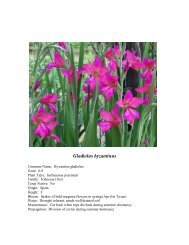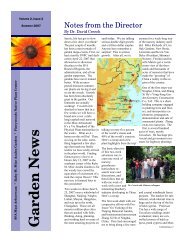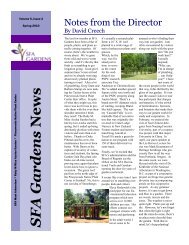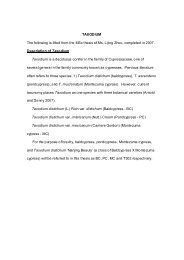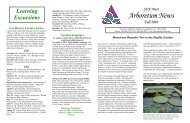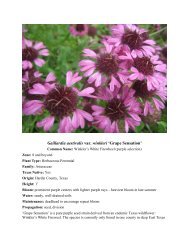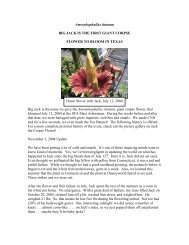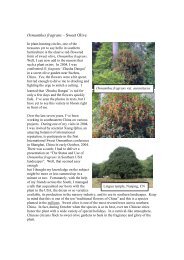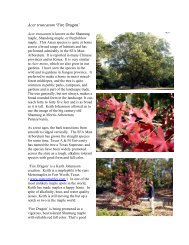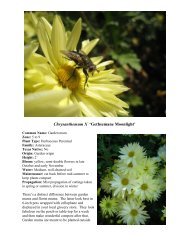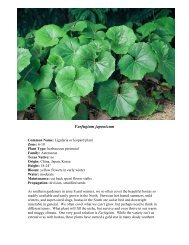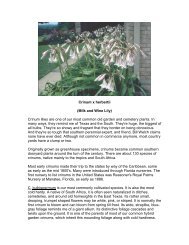native plants primer - SFA Gardens - Stephen F. Austin State ...
native plants primer - SFA Gardens - Stephen F. Austin State ...
native plants primer - SFA Gardens - Stephen F. Austin State ...
Create successful ePaper yourself
Turn your PDF publications into a flip-book with our unique Google optimized e-Paper software.
them away from home, where their merits are better appreciated, and more highly developed, that one<br />
learns for the first time what our gardens have lost by having none of the "American <strong>plants</strong>" in them. “<br />
Isn’t it interesting that most of the trees used in East Texas landscapes are <strong>native</strong>s and most<br />
shrubs are not? Traditions in our plant heritage appear most to blame behind this dichotomy, a<br />
landscape evolution that has led to our present urban landscape philosophy. After all, most early<br />
settlers were too busy worrying about survival to be concerned with landscaping their property. The<br />
interest was with food CROPS - grains, vegetables and fruit dominated their motivation. After security<br />
and a little prosperity settled in, Americans (immigrants with a recent memory of the Old World) were<br />
eager to surround themselves with familiar <strong>plants</strong> from their homeland. Showy, flowering <strong>plants</strong> were<br />
preferred for the home site and old standards made their mark. Quinces, Forsythias, and Spiraeas dot<br />
the south because they are very durable, tend to survive with humans around or not. Native <strong>plants</strong><br />
often failed to make inroads. It was easy for early settlers to move small shrubs, cuttings, and seeds<br />
from one location to another. With <strong>plants</strong> came design. Each ethnic group carved out a philosophy of<br />
display and utility; the swept floor, yard fence, farm garden/orchard and an assortment of perennials<br />
characterized many southern homescapes. Old <strong>plants</strong> - many that lost favor as trends and fashion<br />
concepts changed - are now enjoying a resurgence of interest in a garden public starving for plant<br />
information and for <strong>plants</strong> that last.<br />
In the vernacular of the times, the <strong>native</strong> “xeriscape” garden is one designed to include species<br />
that will survive and thrive without irrigation. In our area of Texas, we can successfully cultivate many<br />
of the dry lovers from this portion of the state and parts west. Besides creating an attractive and less<br />
demanding landscape, a properly maintained xeriscape can conserve a considerable amount of water.<br />
Think about it: each year, Fort Worth area residents pour more than 11 billion gallons of water on their<br />
lawns and gardens, enough water to fill Lake Worth. The cost of providing a safe and plentiful water<br />
supply continues to rise. The average Fort Worth resident's water bill more than doubles during the<br />
summer months of June to September. As much as 50 percent of this additional water is used to<br />
irrigate lawns and gardens. Landscape experts agree that a lawn can be maintained in an attractive<br />
and healthy appearance with up to 50 percent less water than is typically used. Practicing xeriscape<br />
principles results in sustainable landscapes, and at the same time creates attractive and unique<br />
gardens that result in the highest water savings.<br />
The degree of interaction by humans and the “natural” landscape can create differences of<br />
opinion. Surely, we all recognize that <strong>native</strong> plant communities are useful in many types of landscapes,<br />
including urban sites, and are best used to reflect a connection with the <strong>native</strong> natural world. While<br />
only slightly contrived, landscapes that are dominated by the smart use of <strong>native</strong> <strong>plants</strong> are the best<br />
landscapes. In the Mast Arboretum and Ruby M. Mize Azalea Garden which is a mixed (<strong>native</strong> and<br />
non-<strong>native</strong>) landscape, we attempt to extend beyond nature's exemplary combining of plant species. "In<br />
selecting plant combinations, we set out to achieve in a mortal life span what has taken nature<br />
thousands of years to accomplish" (Flint, 1987). What we are attempting to do at the Pineywoods<br />
Native Plant Center and <strong>SFA</strong> Recreational Trails and Garden is skip a succession generation and lay<br />
out a smart selection of <strong>native</strong> trees and shrubs – with diversity, mapping, and documentation the rule.<br />
To position <strong>plants</strong> correctly one should first consider their needs (soils, light, moisture, shade, and how<br />
well they deal with competitive forest root systems. While landscapers can enjoy great latitude in<br />
integrating a diverse palette of plant materials into a garden design theme, some combinations make<br />
little sense – choosing <strong>plants</strong> on light, moisture and soil preferences still allows a limitless list to choose<br />
from. The following woody <strong>native</strong>s are suggested for East Texas and recommendations are based on<br />
observations at the <strong>SFA</strong> Mast Arboretum and Pineywoods Native Plant Center.



